Foam Rolling
Foam Rolling is a great way to improve and maintain flexibility! Foam Rollers are available for purchase at most local fitness shops. Check out the more specific descriptions below for each area of the body. Pictures are courtesy of The Titlelist Performance Institute
Getting Started
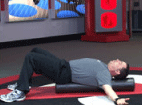 The best way to start to use a foam roller is to place the roller along your spine from top to bottom so your head and pelvis are supported. Check out this link to get a more complete description of getting started with foam rolling.
The best way to start to use a foam roller is to place the roller along your spine from top to bottom so your head and pelvis are supported. Check out this link to get a more complete description of getting started with foam rolling.
Dynamic Spine Rolling
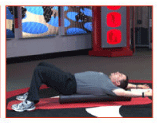 Next you can add some movement into the previous exercise by putting your arms into a 90/90 position and slowly moving them back and forth. This will focus in on the shoulder blade movement. Click here for more instructions on dynamic foam rolling.
Next you can add some movement into the previous exercise by putting your arms into a 90/90 position and slowly moving them back and forth. This will focus in on the shoulder blade movement. Click here for more instructions on dynamic foam rolling.
Mid-Back
 Using the foam roller on the spine can be uncomfortable at first. It is best to try a few rolls at a time to minimize discomfort. Also starting with the upper part of the spine below the neck is a good place to start. Check out this link to see more instructions on mid back foam rolling.
Using the foam roller on the spine can be uncomfortable at first. It is best to try a few rolls at a time to minimize discomfort. Also starting with the upper part of the spine below the neck is a good place to start. Check out this link to see more instructions on mid back foam rolling.
Low-Back
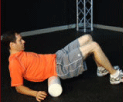 This is a good technique for increasing the flexibility of the low back. However, the low back muscles can be quite sensitive. It is best to use this move as a more advanced technique. Do not use this move if it causes pain. The low back muscles get tight do to weak glute and abdominal muscles so keeping these muscles flexible and supple is very important. Check out these pictures for further instruction on low back foam rolling.
This is a good technique for increasing the flexibility of the low back. However, the low back muscles can be quite sensitive. It is best to use this move as a more advanced technique. Do not use this move if it causes pain. The low back muscles get tight do to weak glute and abdominal muscles so keeping these muscles flexible and supple is very important. Check out these pictures for further instruction on low back foam rolling.
Legs
Hamstrings
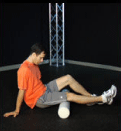 The hamstrings are prone to getting tight in people who have weakness in the glutes and abdominals. Basically you can balance on the foam roller and roll the hamstrings, focus in on any areas that feel tight or sore. For more photo instruction on hamstring foam rolling check out this link.
The hamstrings are prone to getting tight in people who have weakness in the glutes and abdominals. Basically you can balance on the foam roller and roll the hamstrings, focus in on any areas that feel tight or sore. For more photo instruction on hamstring foam rolling check out this link.
Glutes
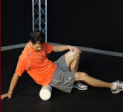 The glutes are important muscles in extension of the body. They help us to stand up straight. There are usually a number of spots in the glutes that can use some attention with the foam roller. Again balance yourself on the foam roller and slowly roll over the glutes looking for sore or tight areas of muscle. For more pictures you can click on the this link of glute foam rolling.
The glutes are important muscles in extension of the body. They help us to stand up straight. There are usually a number of spots in the glutes that can use some attention with the foam roller. Again balance yourself on the foam roller and slowly roll over the glutes looking for sore or tight areas of muscle. For more pictures you can click on the this link of glute foam rolling.
Iliotibial band (TFL-Tensor Fascia Lata)
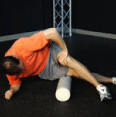 These two tissues are normally known as the IT band. It is located on the sides of the upper leg. It actually has to parts the IT band which is mostly ligamentous and the TFL which is muscle. The ITB is a very tough tissue and responds best to prolonged pressure. This is also a tissue that can be quite sensitive. Start slowly with this area, lay across the foam roller and use the opposite leg for support (this will reduce the pressure on the tissue). Roll slowly looking for sore or tight spots in the ligament. To target the TFL you must roll up at the top of the leg just under bony top edge of the pelvis. For more images on IT band foam rolling check out this link.
These two tissues are normally known as the IT band. It is located on the sides of the upper leg. It actually has to parts the IT band which is mostly ligamentous and the TFL which is muscle. The ITB is a very tough tissue and responds best to prolonged pressure. This is also a tissue that can be quite sensitive. Start slowly with this area, lay across the foam roller and use the opposite leg for support (this will reduce the pressure on the tissue). Roll slowly looking for sore or tight spots in the ligament. To target the TFL you must roll up at the top of the leg just under bony top edge of the pelvis. For more images on IT band foam rolling check out this link.
Calves
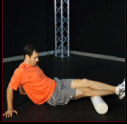 Calves can get tight especially for people who stand for long periods of time. These muscles are very easy to roll out. Simply place calves on foam roller and roll back and forth. To add more pressure you can cross your feet. For more illustration on how to do this check out this link about calf foam rolling.
Calves can get tight especially for people who stand for long periods of time. These muscles are very easy to roll out. Simply place calves on foam roller and roll back and forth. To add more pressure you can cross your feet. For more illustration on how to do this check out this link about calf foam rolling.
Adductors (Groin)
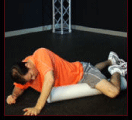 These are the muscles that are on the inside of the leg. This move can be a little awkward but if you go slow you can really find the tender spots. Roll back and forth slowly to find the tender or tight spots on the inside of each leg. Click here for a picture of how to do adductor (groin) rolling.
These are the muscles that are on the inside of the leg. This move can be a little awkward but if you go slow you can really find the tender spots. Roll back and forth slowly to find the tender or tight spots on the inside of each leg. Click here for a picture of how to do adductor (groin) rolling.
Arms
Latissimus Dorsi
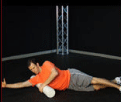 This is the large muscle under the arms. When this muscle gets tight it can cause you not to be able to lift your arms over your head. You can lay on the foam roller with your arm above your head. Then roll slowly on the latissimus dorsi (lat). It can be sensitive because the side of the shoulder blade is in that area. Go slow and find those tender and tight spots in the Lat. For more information and pictures of how to foam roll the lat click here.
This is the large muscle under the arms. When this muscle gets tight it can cause you not to be able to lift your arms over your head. You can lay on the foam roller with your arm above your head. Then roll slowly on the latissimus dorsi (lat). It can be sensitive because the side of the shoulder blade is in that area. Go slow and find those tender and tight spots in the Lat. For more information and pictures of how to foam roll the lat click here.
